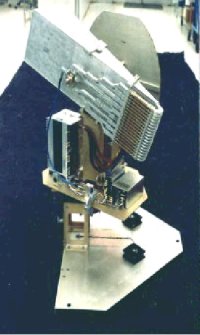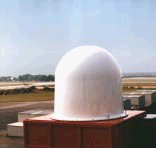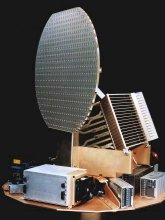Microburst Radar MBR
Description of the radar set, tactical-technical characteristics

Figure 1: Microburstradar, Hornfeed
| Specifications | |
|---|---|
| frequency: | X-Band |
| pulse repetition time (PRT): | |
| pulse repetition frequency (PRF): | |
| pulsewidth (τ): | 7092 Hz |
| receive time: | |
| dead time: | |
| peak power: | 80 watts |
| average power: | 4 watts |
| instrumented range: | 12 nautical miles |
| range resolution: | |
| accuracy: | |
| beamwidth: | |
| hits per scan: | |
| antenna rotation: | 3 rpm. |
| MTBCF: | |
| MTTR: | |
Microburst Radar MBR
This Microburst Radar (MBR) is the first on-airport ground- based system that detects microburst windshear two to five minutes before a hazardous condition occurs. This early warning provides pilots with sufficient time to direct aircraft away from imminent microburst danger. By detecting and continuously tracking the precursors of microburst formations, the MBR detects when and where a hazard will take place. The MBR surface windshear detection capability indicates the existence of hazardous windshear regions at low altitude. All other microburst systems to date can only detect a microburst when it develops on the ground, too late for a safe aircraft landing or departure.
The MBR receiver/transmitter is a modified version of a solid-state, commercial X-Band airborne weather radar, 10 inches wide, 8 inches high, and 13 inches long. The radar antenna developed by Lockheed Martin consists of a small linear phased array that is electronically scanned in elevation (for downdraft detection aloft) and a flat plate pencil beam antenna that is fixed in elevation (for microburst surface outflow detection). This compact antenna measures approximately 3 feet by 3 feet by 2 feet and is mechanically rotated in azimuth.
Picture gallery of the AN/SPS-48

Figure 2: MBR under a radome

Figure 3: MBR, phased array
